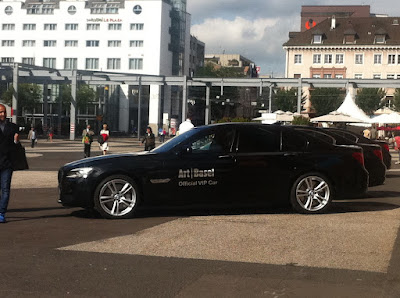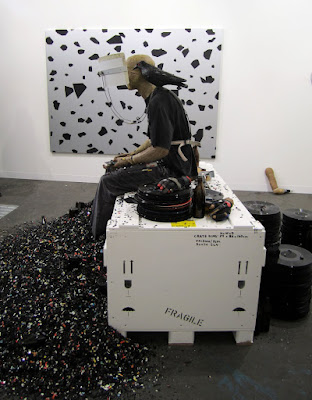First Impressions

Armed with about 1.5 hours of sleep and three German words of no consequence (Zwiebel- from a trip to Germany 12 years ago when I learned how to ask for it on my pizza, Shinken- my grandmother's derogatory nickname for me, and Weiss- as in Edelweiss from the Sound of Music), I headed on the tram to the Messeplatz (Event Hall) where Art Basel is primarily held. To say the least it is a bit overwhelming. There are thousands of people. The extremely well organized event is a flurry of activity to me. It' a little like Disneyland. Each person is a character that plays a roll. From the fleet of Art Basel VIP black BMW's lined up to whisk whichever high roller to their 5 star hotel to the seating area full of lounging socialites between the two main halls. The seating area is constructed of trees, fake grass (not the cheap-o stuff, but what you'd find on a football field) that covers the ground and geometric "hills" made for lounging with your $6 coffee. I drop $20 on a coffee and mini pretzel roll and find a spot to get my bearings. The uniform here is beige. Actually it ranges from Black/Navy to Tan/White as if competing with the art by wearing color is a sort of faux pas. I am wearing a multicolored sun dress and carrying an orange purse. Mental note: be a little less conspicuous. I'm not conspicuous enough to be one of the Lady Gaga type artists who speckle the crowd and not quirky and loud enough to be one of the art students here from Berlin or London but I'm clearly no one with any gravitas either. I'm not ready to go in so I pull out the trusty Mac to digest the last few days in New York. This makes me approachable. Or maybe I just have a coveted table with four chairs and folks are sick of the astroturf.

The first lady to sit with me is an art historian who works for a small auction house in Munich. She looks tired on her third day here. After polite regards she apologizes for her poor English (this is a theme- wherein the apologizer flattens the monolingual with their extensive and helpful command of the English language). After getting her degree in Art History she worked in a gallery for seven years. She moved to this Auction House a few years ago and they have been slowly transitioning from older work (think Albrecht Durur prints) to more Contemporary work. It has been a challenge re-branding their identity. As one of several German auction houses there is fierce competition. She said that her trip to Art Basel is primarily to research what is out there and what is selling. Which Contemporary artists would fit best in the market she is targeting? She said Europeans collect differently than Americans. Europeans have been collecting for a long time. It is something that is more common. They often collect works by a single artist. Americans have also collected for quite some time but it' only since the '80's that anyone thought it could be a good investment. Americans are more into the spectacle. They gravitate to works by artists like Jeff Koons and Damien Hirst. Her trip summary of how the fair has changed over the last few years reflects the recession trends seen everywhere. She said there is more diversity. There are Modern and Contemporary works. The styles vary widely. The scale and prices are diverse enough to hit a whole range of collectors. In general the works are smaller. These are all things I also observed over the next five days



Comments
Post a Comment